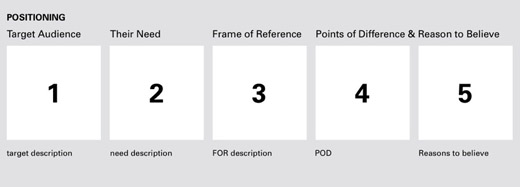Marketing amateurs believe that positioning is just about what makes a brand different. As we’ve explained in previous posts, it is far more. To recap, positioning done right, includes:
1. Your target customer
2. Their need
3. Their frame of reference
4. Your point of difference(s)
5. Your reason(s) to believe
Why is the point of difference so important? Because it is why a customer will choose to resolve their need with your promise instead of the competition’s.
What’s the Difference?
What does your idea do better than the competition? What feature or quality makes your idea unique? Perhaps your idea takes place in a one of a kind permanent location. Maybe you’ve acquired a patent for a unique material or process. Or, perhaps your idea stands out for something simple that may not sound revolutionary – but is dramatically different in your industry or niche. (Like decent customer service or rates for wireless in Canada!)
Unique, Compelling, Relevant, Credible
A great point of difference is hard to come by. It needs to be unique, compelling, relevant, and credible. By “compelling” I mean the point of difference forcefully engages the customer’s attention. By “relevant” I mean it is very important or significant to the customer. By “unique” I mean exactly that. No one else is delivering on the difference, and you can convince people that only you can do it. By “credible” I mean solid, not an abstract fluffy idea that has no teeth nor authenticity.
The Biggest Blunder Right Off the Bat
It is sad that so many people misunderstand the basic concept of positioning. The term itself implies “positioning” against something else. The customer’s need and frame of reference are not what is being positioned. What is being positioned is your brand’s difference against other brands’ differences. Don’t make the all too common mistake of leaving the competition out of the question. And saying that there is no competition is no excuse. Defined honestly, even if you are the only game in town, the customer’s need should be able to be fulfilled – however partially – by alternatives.
This Is How We Do It
In our Distility 1day1brand Workshop, we make sure everyone understands how positioning works. Only then do we go forth with the session, in which:
- The team brainstorms all the emotional benefits, functional benefits and key features the competition credibly promises the customer.
- We brainstorm what additional benefits and features we might credibly promise the customer.
- We extract the features, emotional benefits and functional benefits that we think are most different than the competition.
- We review each one and ask “How well does this resolve the need we identified for the customer?”
- We brainstorm fresh differences, purely from the customer’s perspective. (This is because the client is, sometimes, so steeped in the details of their brand that they can’t see the most brilliant point of difference, which is blindingly obvious.)
- We promote the differences that are compelling, relevant, unique and credible. We demote those that are not.
- We rinse and repeat until we settle on one point of difference.
Occasionally, if a very strong case can be made that two differences are equally strong and important, we choose both.
Innovation Is a Dangerous Point of Difference
Sometimes our clients are so enamored by their innovation that they can’t think of anything else they would rather have for their point of difference. We have to work hard to remind them that what they perceive as a positive difference, – the first use of X technology, for example – may be seen as a negative by the target customer. Most customers don’t want to buy something that is different because it is new. To the contrary, they want to buy solutions that are proven, and no risk.
More on this in our next post: Innovation and the Point of Difference

